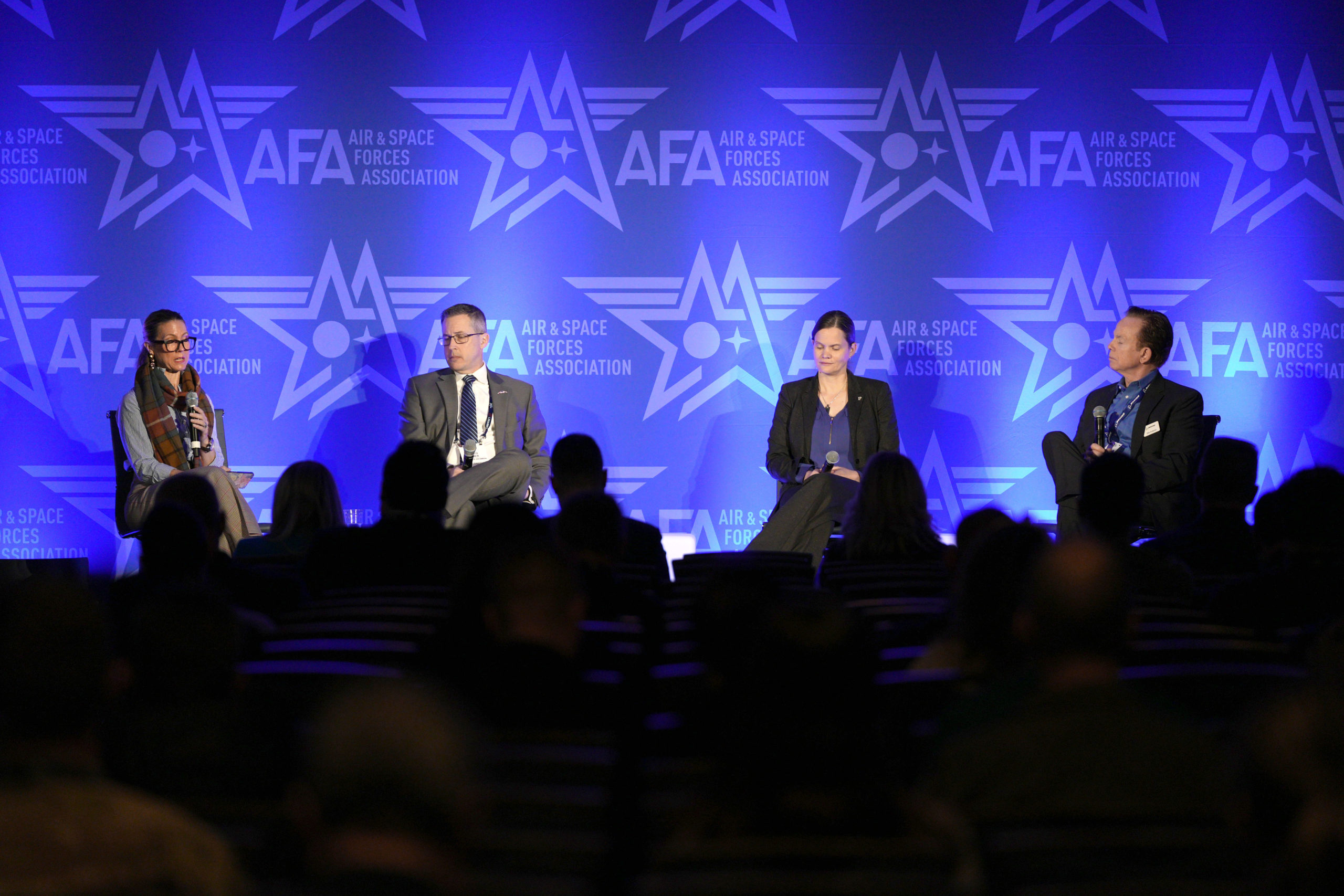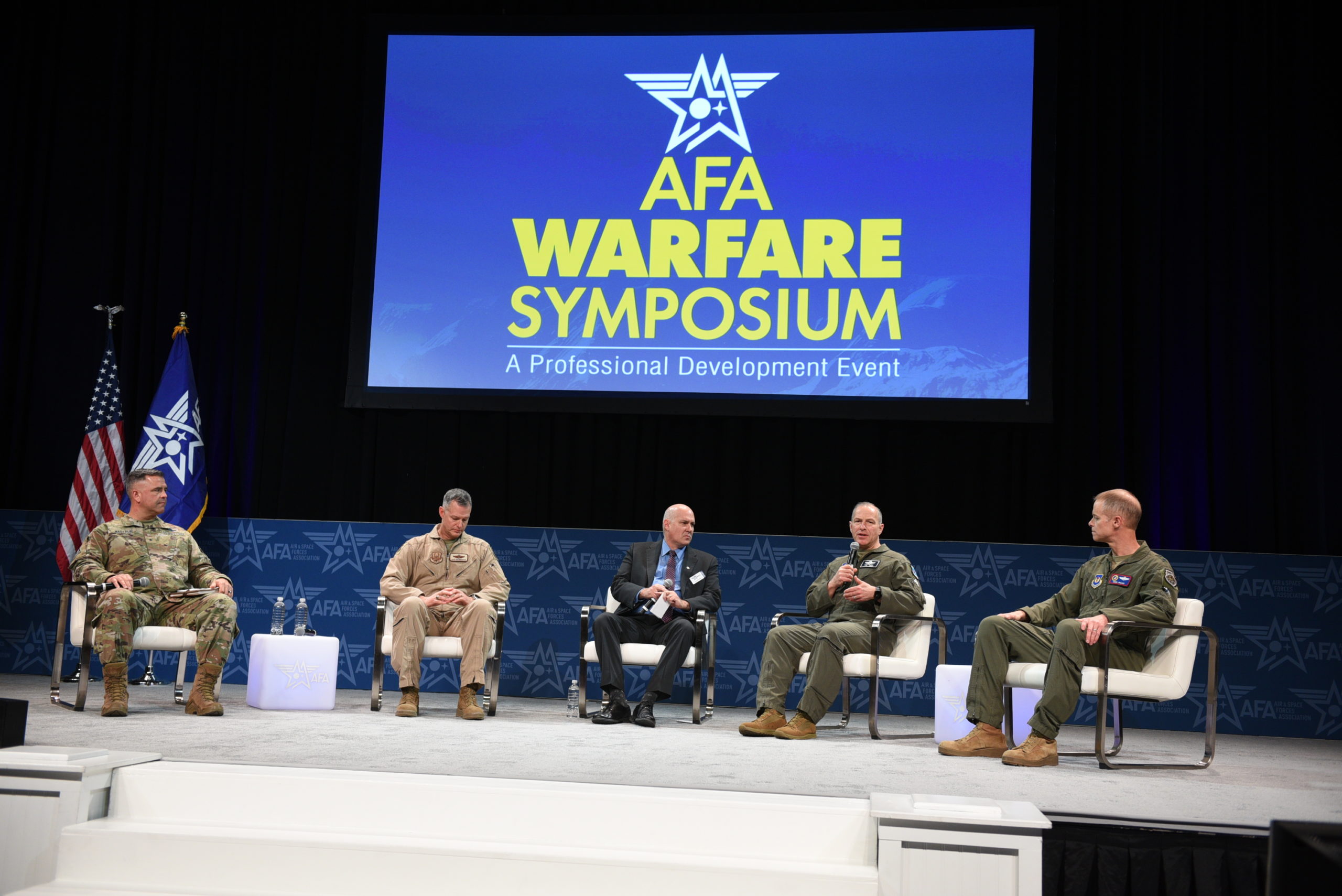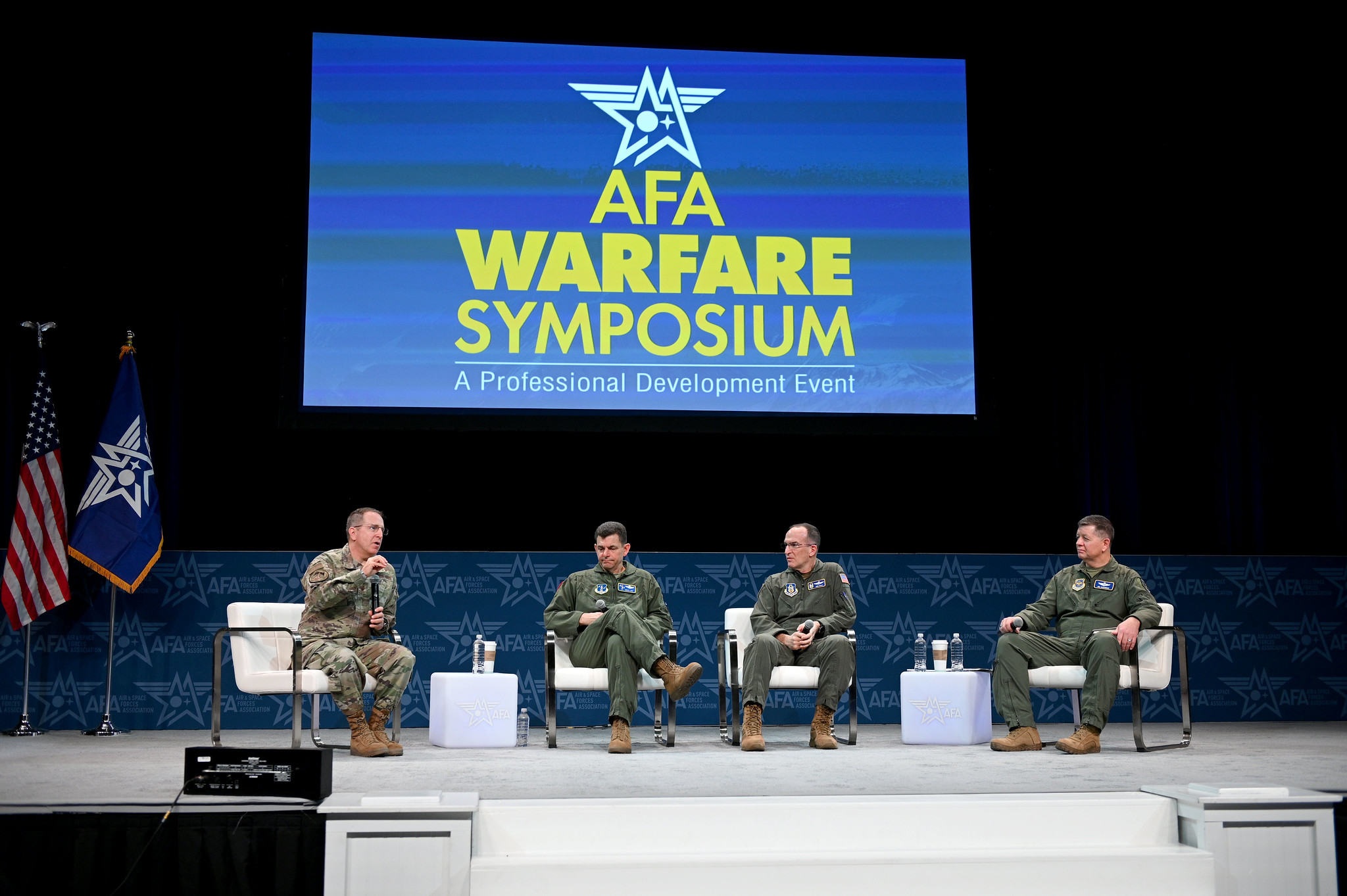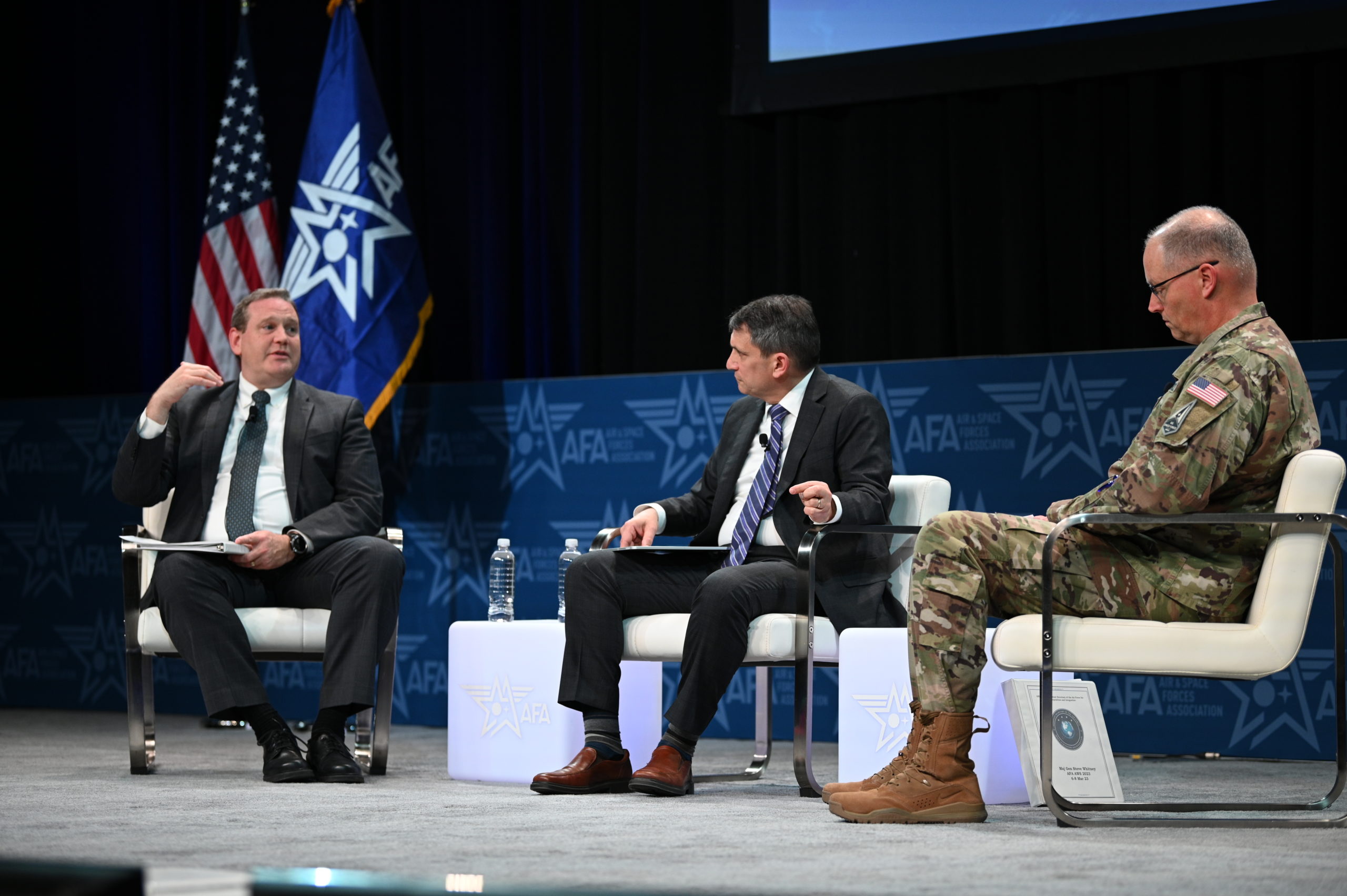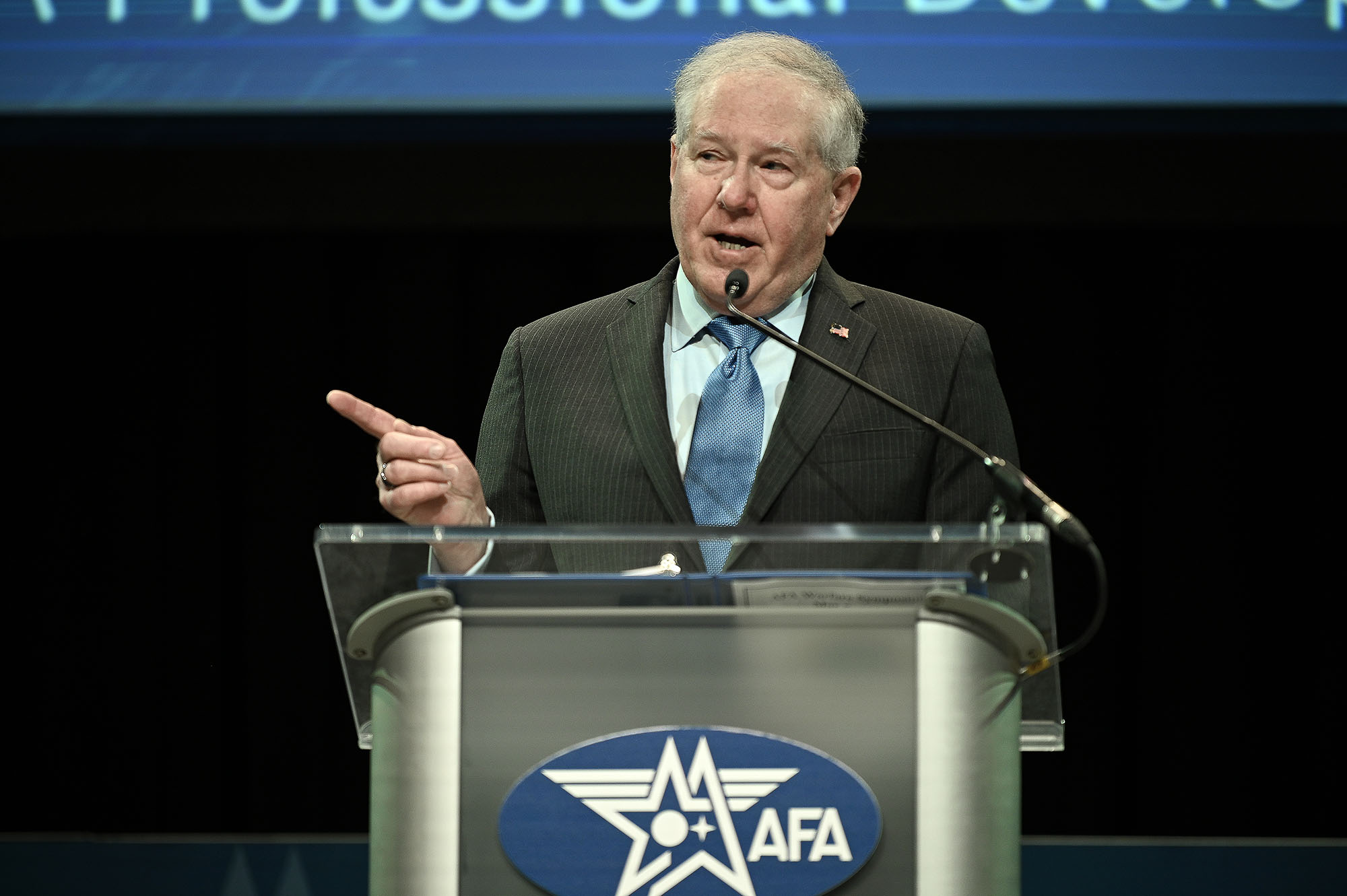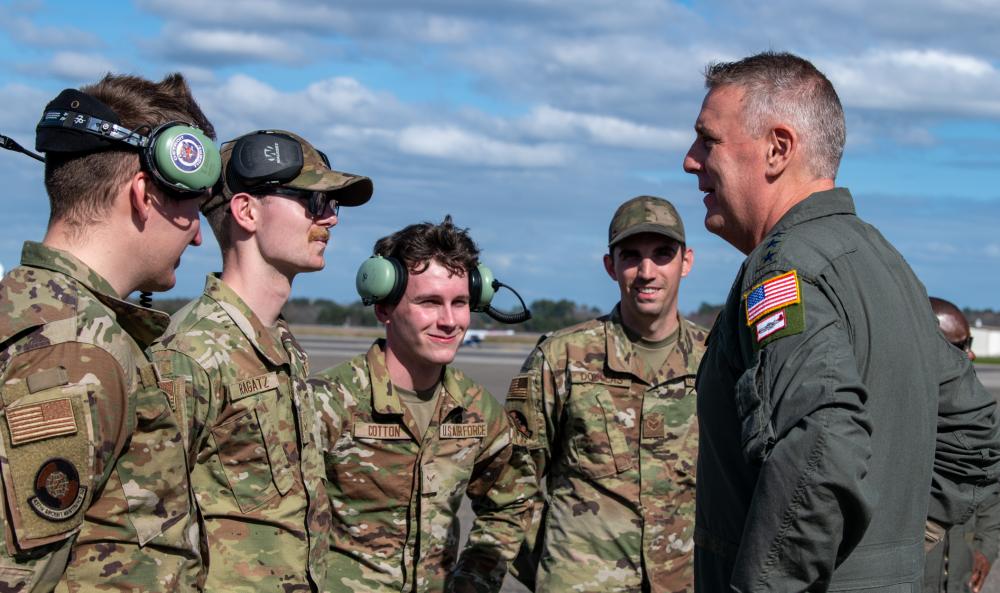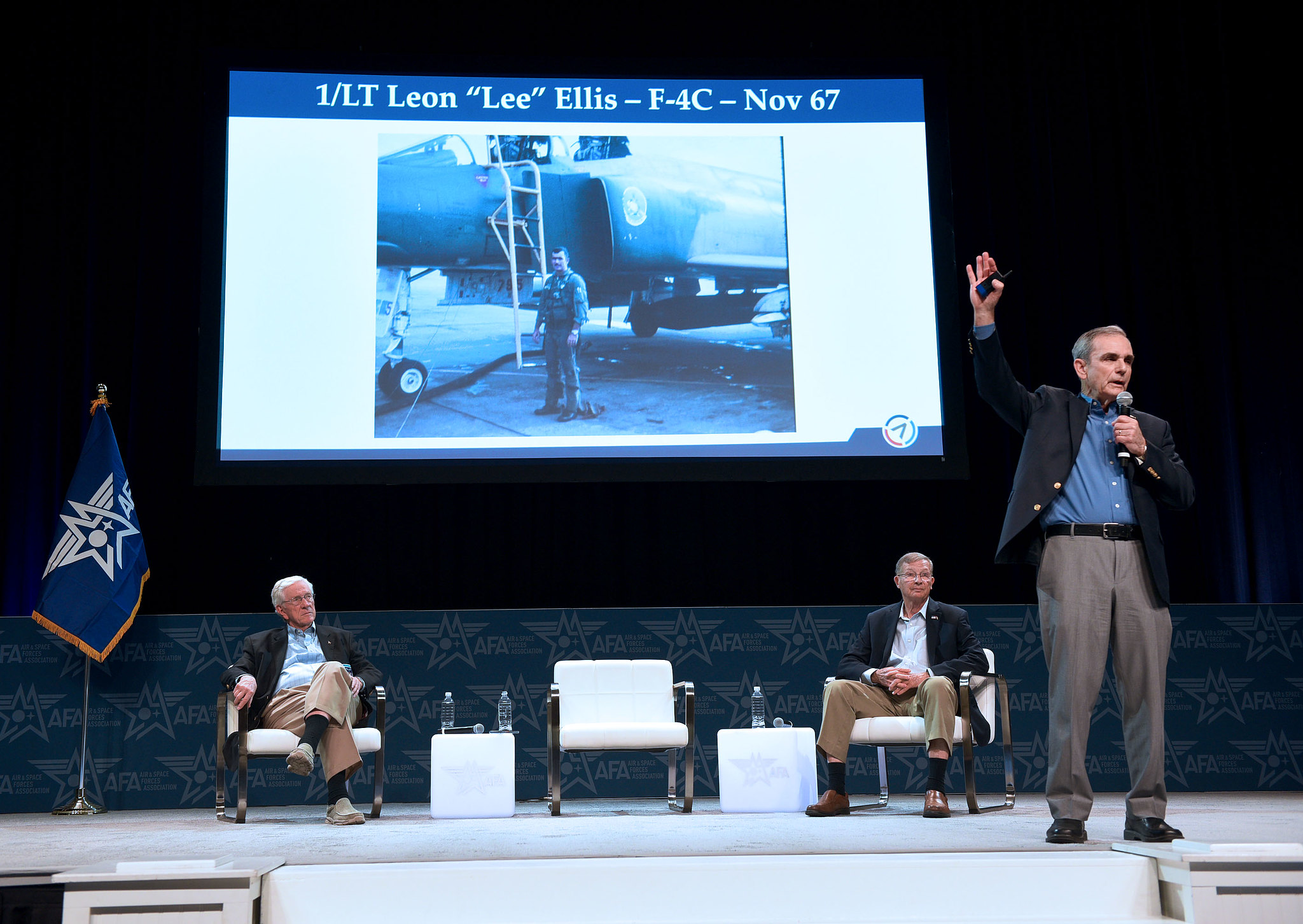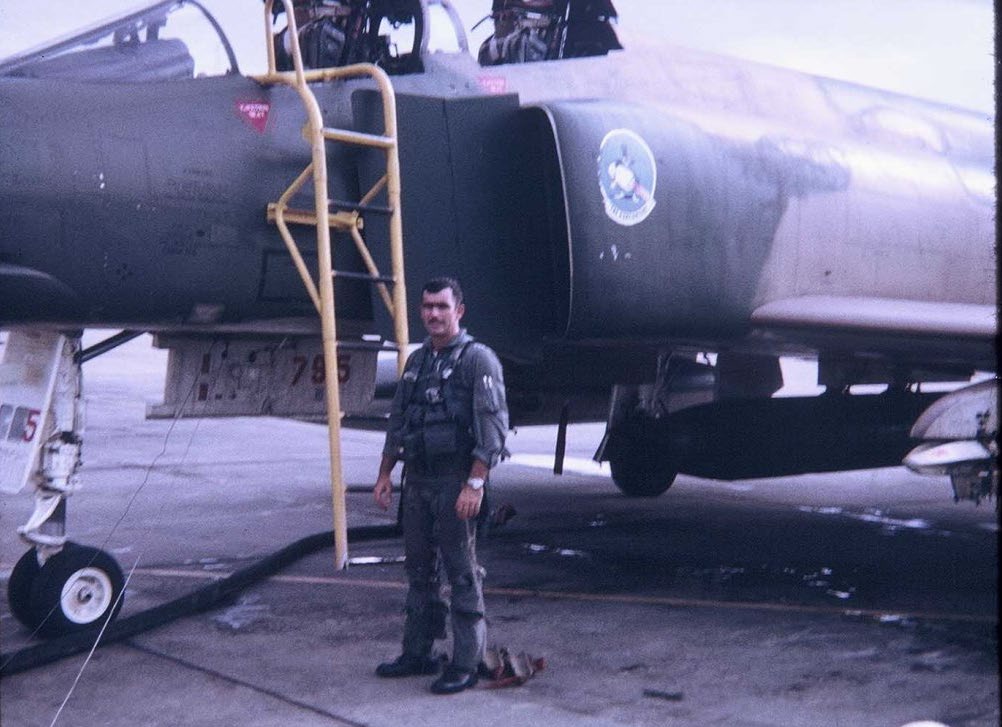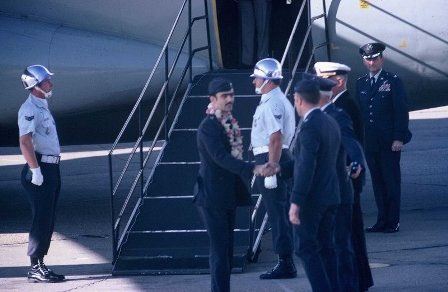Willy Anderson, vice president of Boeing’s Phantom Works; Renee Pasman, vice president of integrated systems for advanced development programs at Lockheed Martin’s Skunk Works; and Gregory Simer, vice president at Northrop Grumman talked about the Air Force’s planned sixth-generation fighter, the Next-Generation Air Dominance program, and the threats and technologies that will help define it in a March 8, 2023, panel discussion at the AFA Warfare Symposium. Heather Penney, senior resident fellow at the Mitchell Institute for Aerospace Studies, moderated. Watch the video or read the transcript below.
Heather Penney:
Good morning everyone, thank you for joining us so early in the morning. O Dark Thirty and I know the coffee lines have been long. I’m Heather Penney, Senior Resident Fellow at the Mitchell Institute for Aerospace Studies, and welcome to our forum discussion on defining the next generation air dominance family of systems. It’s somewhat ironic that we’re hosting a panel on next generation air dominance or NGAD because as we all know, it’s been shrouded in secrecy. But what is no secret is that air dominance is a foundation of how the United States military projects an employs air power and frankly conducts all joint force operations. And despite how successful the Air Force has been at ensuring this freedom to attack and freedom from attack for our sister services and allies and partners, air dominance is not a birthright. We have to continue to earn it in the battle space.
I’m going to take a moment to contextualize where air dominance and the NGAD family of systems approach matters. All you have to do is look at Ukraine. Some folks have learned the wrong lessons from Ukraine and are arguing for a concept that they call air denial, a notion that advocates for ground-based air defense systems instead of what they consider costly air superiority fighter aircraft. First, let’s be clear, both Ukraine and Russia are continuing to fly sorties, theirs not denied, it is contested. If you were able to truly deny the adversary use of the air domain, that’s called air dominance. And why would you not then exploit the air in your combat operations?
Second, our western way of war of combined arms is predicated on air superiority. Our ground forces are not sized or equipped to fight without it. If you want that, that’s a million man plus army and thousands and thousands of tanks, artillery, surface air missiles, et cetera.
Finally, abdicating air superiority and the ability to operate from the air domain reduces a force to a protracted and costly two-dimensional war of attrition and atrocity. And that is what we’re seeing in Ukraine, where both sides have no choice but to feed their sons and daughters into the meat grinder because they do not have air dominance. There is a reason why it echoes World War I. Ground-based air defenses might be cheaper than air dominance fighters of old, but I would argue that an air denial strategy is far more expensive in the cost of actual war in blood and treasure. So when you factor in the family of systems component of next generation air dominance, we have the potential to truly change the game. But I know that you’re not here to listen to me, you’re here to learn from the people who are actually leading the programs that will deliver and get capabilities to the war fighter.
So with that, I would like to introduce our panel. To the left of me is Greg Simer, the Chief technology and Strategy officer for Northrop Grumman where he aligns Northrop Grumman’s technology roadmaps and developmental programs with war fighter needs. Next, we have Renee Pasman with Lockheed Martin Skunk Works. She’s the Vice President of Integrated Systems where she leads strategy development and execution, portfolio management and the transformation for a variety of programs. And finally, we do have a new addition joining us, Willy Anderson from Boeing where he’s a Vice President of Phantom Works with a long history of leading black programs and doing super-secret stuff. So we’ve got the right people in the right places. With that, thank you for joining us today. I’d like to kick things off by giving each one of you a few minutes to introduce yourselves and share some thoughts on this issue. So Greg, let’s start with you.
Gregory Simer:
Thank you Heather, I appreciate the opportunity to represent Northrop Grumman and share with you guys my thoughts on this topic. You succinctly summarized the threat and what we’re up against as a nation. Our peer adversaries are moving fast, they have the ability to be playing a home game as we have to cover the entire world and the entire planet, but we’re up for the challenge in my mind. Northrop Grumman, as many of ou know, recently rolled out the world’s first 6th Gen Platform a few months ago that shows we as a nation are prepared and ready to develop and build the advanced weapon systems that we need.
I’m going to talk a little bit here to start off the other aspects of what air dominance means and in my mind it’s the key technologies like sensors and weapons that are going to enable us to have success in this arena. As we move into these advanced capabilities. we need to be able to keep pace with this adversary as that’s their biggest advantage is they move very, very fast. So our ability to move fast and have weapon systems that last multiple, multiple decades with continuous upgrades is the key to success.
Multi-function sensors that are very open architecture that enable software definition on the sensor so that you can upgrade through software rapidly are a key enabler for this. It will allow us to upgrade these sensors that we get out there on a continual basis. Same thing can be applied to the weapons systems and the weapons missiles and other enablers that and effectors that we can put onto these platforms both from an RFVW perspective but from the weapons themselves as we able to get these electronics and upgrades into the weapons, increased propulsion systems over time and be able to reach out farther to act against our adversaries. Our advantage is our ability to move fast and we need to have systems capabilities and acquisition that allows us to do that and upgrade rapidly over time. I believe we’re ready to solve this challenge and keep up with our adversaries and I look forward to talking more about it today.
Renee Pasman:
Yeah, thank you and also happy to talk to everyone today about this important topic. Greg, I think talked a lot about how a lot of this is really in response to the threat and you summarized very well kind of what happens if we don’t do those type of things. In addition to all of the exciting cool and important technologies that are being worked, have been worked, continue to work and really are being powered by a lot of technological change that just always is going faster and faster and that ability to respond quickly. I think one of the key things that also separates next generation or dominance is our ability to be agile and flexible. Because as quick as the threat is moving, the idea that we will be able to predict with perfect certainty what is going to happen 10 years from now, 15 years from now, or even five years from now is a little bit suspect.
And so it really comes down to how can we make sure that regardless of what the capabilities are that we will need, that we are in a good position to deliver those incredibly quickly and maybe with not a lot of lead time. So whether that is through software defined capabilities where we can compile software a lot faster than we can compile an entire platform. And we’ve seen, from a Lockheed Martin perspective, the benefits of that with 5th Gen already with some of the F-35 and other 5th Gen platforms and how they’re able to fuse that information. But then also how do we bring that to building the actual platform, especially for something like a collaborative combat aircraft. And so whether it’s some of the investments in flexible factories and making sure that we can put together what is needed rather than figure out what’s needed first and then build a factory or things like the investment Lockheed Martin has made in factories for hypersonic weapons to bring that capability online.
Those are some of the key things that as we look at what is needed in addition to the technology, and when a lot of people start to talk about digital and what does that mean for next generation or dominance, it’s not just what we deliver, which is hugely important, but also how we deliver to make sure that we’re delivering on the timeline and not just responding or reacting to the adversary but actually outperforming them. Putting, giving the war fighter the maximum flexibility to put together what they need that day to respond and also get inside what the adversary can do so that they can actually, they need to respond to us.
Heather Penney:
Thank you Renee. Just before we move on to you Willy, I want to comment. I truly believe that speed is the next offset. As you as a nation, we no longer hold a monopoly on advanced technology or development. So it’s really about how quickly we can get that capability to the war fighter. So thank you for bringing speed up, it truly, I believe, is going to be the next offset. Willy, we’d love to hear from you.
Willy Anderson:
Thank you Heather, and thank you for sharing this important discussion. We were joking, the panelists here that we’ve seen each other before, the community is small, even though I was a stand in, we’ve worked together in the past. And my entire goal here is just to make sure that I don’t walk away and lose my clearance. So as we talk about what we’re doing on the Boeing side for the Gen 6 family of systems, it really amounts to two main areas. The first one is alignment within Boeing Defense to support our customers. So if some of those are paying attention to what Boeing’s been doing, in November, we realigned six business units into four and it was very, very intentional, it was very, very specific. And if you look at the individual business units, they’re aligned along the lines of family of systems within these major mission areas.
So Steve Norland, if he was here, he would talk about the new division called Air Dominance. In that division it has all of our man fighters, F-15s, 18, the manned aircraft. It’s also got our unmanned aircraft, it’s got MQ 25, it’s got our CCA areas. It also has our trainer, our newest trainer, T7A Red Hawk. And throughout that, the reason why we’ve clustered them together is because it gives us some synergy, some lift and speed if you will. And underneath that also is Phantom Works. Phantom Works doesn’t just support this business unit sports, all of BDS. But we’re housed under air dominance and the reason is the technologies and the innovation that’s come out of Phantom Works directly feeds these platforms allows us to speed that Heather was talking about. The next area is we’ve been investing for years, maybe even decades for this moment in the investments come along three different areas.
The digital engineering is not just a buzzword with us, MBSC digital thread, digital twin, we’re actually making that come true and it’s a reality. We’re also investing heavily and by that I mean significantly more than a billion dollars has gone into our advanced factories. We built a new factory for the MQ25 new digital factory, new digital factory for our composite facilities down at Mesa and we have three new advanced manufacturing facilities going in St. Louis. So we’ve been investing in the future for Boeing manufacturing and now if you connect digital engineering and factories, which we’re really talking about is that speed again that Heather mentioned and it’s speed in the life cycle, it’s speed in engineering, it’s speed in manufacturing, it’s speed in sustainment and test all of that. That is a digital link and allows us to be able to react very, very quickly to support the war fighter as well as any kind of anomalies and things like that they may see out in the field for this advancing threat.
Heather Penney:
Thank you Willy. So I’ve got a question, you couldn’t have been a straighter man in terms of setting me up for my next question regarding family of systems, right? We know that next generation air dominance is going to be a family of systems, it’s not going to be the traditional single awesome fighter aircraft that we’ve had in the past, right, that we all know and love dearly. How would you describe family of systems and why is that so important as we begin to move into the future and how’s that going to provide us that combat edge over our peer adversaries? Who wants to jump in?
Gregory Simer:
I can start. In my mind, it’s more cowbell, it’s affordable mass and it also adds to the flexibility and agility that we all talked about up here. If you think about being able to bring new capability, whether it’s carrying a new weapon, it’s whether it’s carrying a new sensor or whether it’s a different envelope from a platform perspective that you need it. You don’t have to dev design an entirely new platform. You can send something as a wingman that goes with the primary vehicle, whether it’s an F35 and F22 and get whatever it is we’re talking about it. It gives you agility and also from a sensors perspective, we all talked about digital engineering, we all talked about open architectures. As long as you’re designing the sensors, the systems, the weapons that go onto these platforms so that they can be interchangeable, you can now change your outer mold line and get another capability forward. And not everything has to be manned. So by having unmanned platforms take off the load of some of the capabilities and needs that we have down range, you can bring more to the fight and it’s all about being affordable and controlling costs.
Renee Pasman:
The other interesting thing to me from a family systems capability is the so yes agility, flexibility for the war fighter in terms of putting packages together but also a sense of resiliency. The difference between a point-to-point network and a mesh network, if one element of your next generation capabilities is not available that day or something breaks, now you have that ability to just with a network heal, come up with a different approach, come up with something else and you don’t have to go and re-plan and not get the mission done that particular day. And so not just resiliency in the sense of okay, we’ve got multiple IT infrastructures or something like that, but really resiliency in how the war fighter can respond to the threat and there’s an element of unpredictability in there and that element of strategic flexibility that I think it’s really important as we prepare for this threat that is out there.
Heather Penney:
Renee, you bring up some really good points regarding capacity provides capability in and of itself, it isn’t simply about mass. Although, when we look at the scale and the scope of what will be required, that’s definitely that required. But China plans to dismantle our systems and disrupting the relationships, targeting our networks, our key elements of their strategy. And also they have been studying us for years and we’ve become very predictable. So that unpredictability, that ability to reform those relationships through the family of systems and the resiliency of networks I think is very key to really sidestepping the way that China plans to target us. Willy, I’d like to go back to comments that you made regarding speed. So you guys are making major investments so that you can go fast, so you can be responsive to the war fighter, you can be responsive to the strategic environment. Every single one of your companies upstage are doing this. What does the government need to do to be able to go fast with you?
Willy Anderson:
Well, there’s a couple of things that they have done and a couple of things that might be in work that they really need to finish. Number one, they have been tackling at least one barrier to speed which is kind of the traditional wave contracting, through IDIQs, BPAers, task orders, they’ve been changing how they do contracting to be able to speed to contract, which is a key area that slows us all down.
I’m going to echo something that Greg said, the whole drive to open mission systems has been a huge enabler for the government and for us. And I’m not talking tier one [inaudible 00:16:36] mess with a wrap around it. No, no, no, you got to get down to tier three, you need to be at the box level and that’s where you’re competing at that level to be able to get new things in that might be compliant but that’s how you get speed and development.
But an area that they still need a lot of work in, a lot of work in is in security. Those of you that deal in our world here, we have security constraints for the obvious reasons and so forth, but we’re not allowed to be able to easily connect programs together and a huge opportunity from a government side is continue to go down this new initiative that the dev has pushed on to be able to eliminate a large number of security programs and combine things, not able to easily combine programs and technologies together is slowing us down. we’ve done a lot of investment in a lot of different technologies but I can’t take IRAD investment and move it over unless it’s on a DD 2 54 and in a program that allows me to be able to do that, all that stuff has to be cleaned up. He’s kicked it off but he’s got a long ways to go. Call it security reform.
Heather Penney:
Thank you and especially since you come from a long career of having been in the acquisition world from the black side. So I’d like to also then pivot to the role of collaborative combat aircraft because all three of you mentioned that. And I know that I’m competing with the CCA panel next door with Dr. Caitlin Lee since you’re here sitting with me, make sure you catch her panel on the videos that we’ll post up later. So on the role of collaborative combat aircraft, we understand that NGAD family systems will employ other systems. So what role will these CCAs play and what do you envision the relationship between NGAD and CCAs?
Renee Pasman:
To me, when you look at CCA, part of the interesting bit is taking a lot of the technologies we’ve talked about like digital engineering, like open system architecture which are really just entry points at this point to these opportunities, one thing that enables is to say, “Well we don’t know what role CCA is going to play yet and we don’t need to because we should be able to take these technologies, put together something very quickly, ensure that it gets delivered, all of those types of elements.” When you think “Okay, but what could they do right?” There is a lot of support functionality that can be delivered through an unmanned platform. I think we have to resist the urge to say, “Well, they could do weapons, they could do sensors, they could do this, they could do that,” let’s put all of that together on a platform because then you just have more expensive platforms and you can’t use CCA to deliver to grow the mass like Greg mentioned that I think is a capability as well.
But I think tailoring it to what is most useful in the fight and there may be different versions of a CCA platform, one that is more optimized for activities that are more a little bit further away from the leading edge, others that are more a little bit further. There’s a really interesting discussion that’s been happening for years on how important weapons development is for next generation capabilities. And so whether it is making sure that we’re getting the most out of the weapons that we have or maybe linking… If there’s something interesting and new and different that we can use to tie weapons development and aircraft development from a CCA perspective together, that might create a very unexpected capability. But again to me the interesting part for CCA is, regardless of the specific widget, right, how do we use it and how does it interface back with the man platforms, by focusing on that we give the use case some time to develop and then be able to deliver that quickly.
Gregory Simer:
To pile on to that, I agree on the weapons completely, it’s been four-
Heather Penney:
Let’s just go there, let’s just talk about weapons, cause we know we need weapons, we need masks, we need next generation, we need to have the right ranges. So let’s just go, let’s talk about weapons.
Gregory Simer:
So it’s been four to five decades since a weapon and the platform have been designed concurrently so that we’re actually pairing the weapons with the weapon system that can carry it to the fight. So we’ve mentioned all the characteristics that we need to think about. It’s range, it’s speed, it’s the ability to sense and be able to find the right targets and it’s also the ability to communicate with the weapons, and it doesn’t necessarily have to be from the platform that’s firing the weapon or even if the weapon’s coming from further back and maybe even our navy friends. If we can communicate and do the forward pass engage on remotes, it unlocks a lot more capability.
And to further pile onto what Renee was talking about it’s all about controlling the ultimate cost of this network of capabilities. You can make trades on the weapon propulsion and range if you have a CCA that can carry it farther, you can make the weapon more expensive and not have to send something forward that you now have to recover in land. So there’s a lot of interesting cost trades then it can now be considered as we look at the complete family of systems of man fighters, unmanned platforms and then the weapons that all of them will carry forward.
Willy Anderson:
I think from a weapon side there’s really three areas that we could do to improve the weapons element of it. First off, if we drive OMS down into the weapon, and I know I’m making this very simplistic, but you should be able to look at this like Lego blocks. You know can take a motor, you can attach to a guidance system, they ought to be Lego blocks and now you increase your effectiveness by throwing on different sensors on the front end of it. And I know it’s simplistic but we can do an awful lot more if we drove OMS down into the weapon. The next is the element that Greg talked about is that weapons are going to be networked, you’re going to have F-15 EXs launching, I mean the loadout has been increased, they’re going to be launching weapons from a distance and then they’re going to leave. They’re not going to be the ones guiding them, other people are going to be guiding cause it’s going to be on a network.
And then the last piece of it is the autonomy really is a thought but it’s coming quickly. Those weapons are going to be able to go in, they’re going to be able to take a look at the target they were assigned to and say that target’s already hit, I’m going to go hit my second or third order target and in now you’re bringing a whole lot more mass and in a smart way.
Heather Penney:
Thank you. So let’s talk again about speed. What components of the NGAD family of systems do you see as the largest stumbling block to NGAD development? I mean after all, it has taken us decades to really develop new aircraft capability. B21 has been the fastest development that we’ve seen in more than one generation. So we will need to replicate that kind of speed of design and delivery of not just NGAD itself but also the family of systems because we know that its efficacy is going to be predicated on fielding those relationships in the battle space. So what do you all see as the biggest stumbling block to accelerating speed with NGAD and then also the family of systems so we make sure that we get them all fielded near simultaneously?
Renee Pasman:
Not to get to practical and down in the weeds, but I’ll echo what Willy said from a security perspective, right? In the past we might have said, “Well, the acquisition approaches or funding stability or stability of vision,” I think particularly on the latter one, the Air Force has been very clear on what their vision is even as it continues to evolve and that I think stability of vision has been very helpful, there’s been significant shifts in that acquisition approach that allows for a lot more of that agility and flexibility.
But when that all comes back down to great, we’ve got capabilities getting developed in multiple different places, but your TTR takes at least six months and maybe a little bit longer and so now you are under the, “Do I do it again?” Or on the cybersecurity side, right, there’s been so much change when you look at even some of the things that were on the exhibition floor today with AI software capabilities, things like that, if we can’t bring those things in easily with the appropriate policies and whatnot to really not have to reinvent those things to be able to push them, to be able to put those different innovations together, that will end up being the limiting factor on how quickly we can move. Because I think a lot of the things, whether it’s the digital engineering, the software development that is coming off of a lot of the current programs, we can develop the capability quickly but making sure we’re actually putting it together and not getting held up by our own policies I think is one of the stumbling blocks from a speed perspective.
Willy Anderson:
I’m going to go back to something that Secretary Kendall said in his opening remarks, they’re planning for two CCAs to a Gen 6 or an F35 platform, but one of those stumbling blocks to making this reality is data, right? And so it’s not just going to be this mission set of platforms, they need to get data, they’re going to be tied to space assets, they’re going to be tied to airborne command and control assets, the whole Jet-E2 ABMS area. General Cropsey is making some great strides in that area but he’s got a long way to go and part of that is synchronizing the work that the space architecture is doing related to that’s still a journey ahead of us. They’ve got a lot of challenges to be able to go through and for essentially the family as systems to be successful, they need to be successful.
Gregory Simer:
I’ll touch on one thing that’s not even related to technology, it’s people. B21 as you pointed out proved we can do it and we can do it quickly, but having the cleared workforce and maintaining that cleared workforce is going to be one of the biggest challenges to moving quickly with this wide array of new developments going on simultaneously. This is the coolest stuff you could possibly work on. It should make it easy to recruit but it’s a challenging workforce out there right now to make sure that we have the smart people in these jobs cleared to the right access is to go solve the problems.
Heather Penney:
Yeah, that’s a really good point and I think one that worries every single one of us in industry is that next generation and being able to ensure that we have the skilled workforce because there’s so much competition out there for those engineers. So let’s get back to affordable mass and we’ve talked about weapons being a means to achieve affordable mass, CCA as a means to be able to achieve affordable mass, but it all comes down to cost, right?
And we were all familiar with the term no bucks, no Buck Rogers. So public statements indicate that the manned component of NGAD is expected to cost in the hundreds of millions, right, with unmanned components being in tens of millions. And so I think we’re all concerned as we look at budget pressures, how cost could impact production rate and quantity. I mean for example, the aircraft that we have right now, we need to be able to accelerate the production rate because the demand for them is today, it’s not 10 years from now. So from an industry perspective, how do we control costs such that we can buy the number we need at the rate that we need?
Gregory Simer:
We all mentioned it in some arena but open architectures are going to help a lot. Quantity drives cost and affordability, the ability to design and spit out thousands of iPhones makes them affordable enough that we can all carry one in our pocket. As we could move to open architectures and we can take the same technology electronics, processors even aeroframe designs and move them from a man fighter to an unmanned fighter and even aspects into weapons, it allows us to get scale up which is going to drive affordability. As long as we keep with the open architectures, maintain these architectures so things are portable across industry so that I’m using the same capabilities and technology that Renee and Willy are using in each of their designs. It’s going to drive cost down at the supplier levels and allow us to get the scale up.
Renee Pasman:
The other thing we’ve all talked about, various digital manufacturing, things like that and I think that is also a key element because just open architecture kind of forces us all to think differently about how we move capabilities across platforms, I think some of the advanced manufacturing capabilities and techniques allow us to change how we build things and bring the cost down that way because we have to do business differently in order to support these kind of affordability goals which are important because that is also a way that the Air Force can have the flexibility that they need to purchase the systems that they need for this particular situation. And if we were still doing compute the way we were doing in the eighties and the nineties and had projected that forward, none of us would be able to afford the iPhones that we now all have in our pocket. But to Greg’s point, technology changed the way those were put together, changed the way business was done, changed and I think that’s a key part from a transformation perspective to make sure that we can hit those affordability targets
Willy Anderson:
To control costs, one element the way to look at it is to essentially shrink, reduce the life cycle, make it quicker to be able to get capability in the hands of the war fighter. Lots of elements of that that we could spend all day talking about to OMS is certainly one of them. So in the area of advanced manufacturing to prove that point, we’re doing full scale determinate assembly, FSDA, and that what that is taking a digital model, handing it to a supplier, he pre-drilled the holes and then it comes to us and that part and we have first time quality and we just mate the part up the T7A Red Hawk is a success story along those lines.
Essentially if you look at the production line, you were to walk that as I did you know have a couple of ladders and a few tool carts that are along that you don’t have the big stanchion arrays around the platform as it’s going. It came together very, very quickly and that’s an example, a testament of how you can shrink that life cycle down and it applies to sustainment, it applies all across the life cycle of a program.
Renee Pasman:
Just to add to that, cause we’ve all talked about manufacturing and design, which is most of what our companies do, but one area that is also I think very important from a affordability perspective and also a speed to the war fighter perspective that we haven’t talked about is test, test and evaluation. When we look at fifth gen and what it took to get that advanced of the capability in the hands of the war fighter, there’s significant time spent in testing. I think one of the really interesting areas for continued collaboration and discussion is how do we take the power that is inherent from a digital thread, digital twin that we’re using very successfully in design and in build and now start to apply that to test and how do we take some of the advanced capabilities like data analytics, AIML, those types of things and bring that test timeline down to both speed delivery and help from an affordability perspective.
Heather Penney:
Thank you for bringing up that important point because there’s so many key components of actually delivering capability that we don’t necessarily think about and I think test is one of those that drives a significant amount of time and cost into delivering a program. It’s not to say that it’s not important, but I think there are different ways that we can think about doing that. So Greg, I’d like to toss in this next question to you. Actually before we do that, the other thing I think is really important is as much as we talk about cost, what you all are doing is looking at how can we build inherent affordability into the design, into the manufacturing. And it’s not going to make these platforms cheap, but I think we need to ask ourselves what’s the cost if we do not procure these systems? There are certain elements of cost that if you’re in the industry there’s a rule of thumb that there’s a cost per pound and that roughly approximates the raw materials and so forth that are demanded based off of the mission set for the aircraft.
So if the vehicle has to go far, if it has to go fast, if it has to carry a lot of payload, those are going to just drive certain sort of non-negotiables for the raw materials there. But you all are looking very interestingly about how do we look at where we can create advancements to build inherent affordability as opposed to economic tricks of procurement. Because I would say that we could use a little bit more help of stability within our government partners if that was actually the way we had to build affordability into systems. So very quickly I’d like to is Greg talk about 6th generation, what does next generation or 6th generation mean? Because we understand that 5th generation was a step magnitude of capability above 4th generation aircraft. So what does 6th generation mean? What is that step magnitude increase of capability or effectiveness? How would you define that and then to open that up to the rest of the team.
Gregory Simer:
I think we hit on many of the aspects of what 6th Gen means to me and you even mentioned as speed as the next offset it. I really believe that’s where we’re getting all of our performance characteristics across the board are just getting better and better. But those are an evolutionary step as we develop technology and get it into capabilities. Really what we mean as in 6th Gen or what I see in 6th Gen is our agility and speed, being able to upgrade hardware as frequencies and power and all of the aspects of performance improve for an array or for a propulsion system, having those open architectures and the digital engineering and all the design aspects that we’ve talked about that we can get that capability on board fast and have a continuously evolving and maturing capability over the lifespan so that we don’t have these fixed 30, 40 year programs is my view of where we’re going.
Renee Pasman:
I think so certainly agility, speed, to your point, that flexibility to me, one of the things that defines next generation is that power of the network, the family of systems approach. A single platform is not necessarily next gen in and of itself, that idea of going in alone and unafraid, those types of things, we’ve seen I think the absolute maximum of that capability with the 5th Gen Platforms and now when we see that capability in the hands of our war fighter, they are already starting to come up with how to use those platforms in different, more advanced ways that would not have been envisioned when those initially were put together. I think it’s taking those ideas and making that the point that to me really defines the next generation. It’s that family systems component, bringing it all together and really taking the capabilities that we’ve had in 5th Gen on a platform level but now to the entire system of systems
Willy Anderson:
And there’s an area of speed and agility that we really haven’t talked too much about which is in the software area. So a key element of this is going to be how quickly can we do software upgrades, get it through the pipeline, check it out, test it, and get it onto a platform. Excuse me. So in the area of autonomy that’s going to be a rich area, the three companies here don’t own all this brain trust related to autonomy. There’s a lot of it going on out there.
But integrating it onto a platform so that the platform can perform and can test safety of flight, all those things and so it’s not a wild west. What we’re doing is we’re taking a look at a framework and essentially partitioning off the safety critical elements of it and then divi defining the interfaces so that third parties can now connect with us and be able to quickly be able to add capability onto say CCA platforms of the future.
And then we’ll work through the whole integration test element that Renee mentioned and be able to get that capability out as quickly as possible. And in some cases, in fact we just tested it last week at Emerald Flag is being able to take software from our software factory and we piped it over a SATCOM communication link into an aircraft that in the air we’re going to be doing that in some cases for an update to a threat file or whatever as aircraft are inbound. All points to agility and speed for the war fighter, being able to be flexibility and I think that’s a core element of Gen 6.
Heather Penney:
Thank you. So we’re coming close towards the end of our time. So what I’d like to do is have a lightning round. From each of you, what is one thing that or actually on my last lightning round we had two or three things, but what would you like our audience to learn or think about next generation air dominance before they leave this room that we haven’t already touched upon or that you’d like to foot stomp?
Willy Anderson:
Well, I’ll jump out in front so that I’ve got one thing in my head and if they take it I’m in trouble. So I think from a lightning round and this does apply at all three companies as well as probably everybody in this room and it’s innovation. So we are at a time now with an adversary that’s moving fast, it’s highly intelligent, it’s throwing a lot at us. We need to be able to as an industry, be able to come together, work together, partner together so that we can get speed to innovation. And now it’s the open architecture, the software, everything that we’ve been talking up here are key elements to being able to do that, but we need to be able to, hey, you’ve got something over there that really helps, that’s cool. Hey, let’s partner up. Let’s get it on to an aircraft, let’s get it on test and get it out to the war fighter. I think that’s critical.
Renee Pasman:
Yeah, partnership I think is my one word answer, whether it is in the innovation space and bringing capabilities, whether it is partnership between the government and industry to understand as the threat is moving or capabilities change, what is it that is needed? And also partnership with an industry, whether it’s things like the consortium activities with open mission systems and how do we drive that forward. We’re all on this journey together. We’re all working to figure it out. Even partnership on people, which is one of the most precious resources that we have to make sure that we’re truly bringing the best of the nation to bear on this problem and not individual stove fights.
Gregory Simer:
I’ll revisit a term I’ve used a couple times and that’s agility. If you look at where technology was even a decade ago, it’s just moved so fast. To foot stomp Willy’s comment on innovation, we need to be agile, we can’t be fixed in requirements and stick to those requirements for decades. We have to look at where technology moves and we need to be agile to be able to get that capability out there to the war fighter quickly.
Heather Penney:
Thank you. Ladies and gentlemen, we’ve come to the end of this discussion and I’d once again like to thank all of our guests for their time and their insights. And from all of us at the Air Force Association and the Mitchell Institute, have a great aerospace power kind of day.
